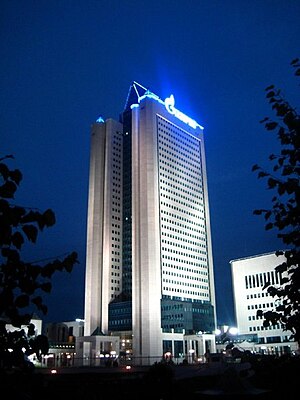 |
| Gazprom Headquarters (credit: Wikipedia) |
South Stream is to be completed by 2015 and will provide Central Europe with up to 63 billion cubic metres of gas per year. Along with the Russian state company Gazprom, which holds 50 percent of shares, other major participants in the project are the German company Wintershall, the French company EDF, and the Italian energy group Eni.
South Stream is of considerable political importance: it will undermine the monopoly position of Ukraine as a transit country for gas supplies and ensure that Europe continues to receive a large proportion of its gas from Russia.
Russian president Vladimir Putin, who personally participated in the opening ceremony, had brought forward the start of construction, which had been originally scheduled for 2013. The financing of the pipeline, which will cost the unprecedented sum of at least €16 billion (US$21 billion), remains unclear. The final investment decision has been repeatedly postponed in recent months.
The legal basis for laying the pipeline in several EU member states also has to be resolved. Brussels officials have previously denied a permit for construction due to the lack of clear financing proposals and the absence of a definitive plan for the pipeline route.
For some time, the European Union (EU) has been trying to limit Russia’s influence on the European energy market, fearing that too great a dependence on Russian gas by EU states—first and foremost Germany—could be used by the Kremlin to exert political influence. On the Russian side, its energy exports to western Europe are of great economic importance.
The EU is all the more keen to reduce this dependence against a background of growing tensions with Russia in recent months, mainly due to opposing interests in the Syrian conflict and Western preparations for war against Iran.
The EU Third Energy Package agreed on in 2009 provides for a separation of suppliers and network operators, threatening several Russian pipelines that are supplied and operated by Gazprom. Gazprom is seeking to ensure that North Stream and South Stream are exempt from the regulations. Should this not take place, the Russian state company could lose control of the pipelines in which it has invested billions of euros.
As recently as September, the European Commission also undertook an antitrust case against Gazprom, alleging the company had violated anti-monopoly law (see “EU launches anti-monopoly suit against Russia’s Gazprom”).
In addition, the EU has tried to transport gas from the Caspian Sea to Central Europe via the Nabucco pipeline without Russia’s involvement. The Nabucco project, however, was significantly reduced this year and renamed Nabucco West.
Beginning in 2018, the Trans-Anatolian pipeline (TANAP) and Nabucco West aim to transport around 10 billion cubic metres of gas from Azerbaijan to Central Europe. If Russia were not to go ahead with South Stream, then a realisation of the originally planned Nabucco project would severely undermine Russia’s dominance in Europe’s energy market.
In going ahead with construction of South Stream, Moscow also aims to increase its pressure on Ukraine. The fees currently charged by the country for the transit of Russian gas to western Europe are of great importance for the Ukrainian economy.
South Stream will be the second major natural gas pipeline to bypass Ukraine, following on the heels of North Stream, which transports gas from Russia through the Baltic Sea directly to Germany. The North Stream pipeline commenced operations in November of last year.
The new North Stream transit route has led to a 21.3 percent drop in Russian gas supplies to western Europe through Ukraine this year. The majority of the 63 billion cubic metres to be transported by South Stream are currently delivered via Ukraine. This means that the completion of the South Stream project will have a serious impact on the Ukrainian economy.
Moscow is using its pipeline policy to weld closer economic links to the former republics of the Soviet Union and eastern European countries. These countries have been severely affected by the global economic crisis and obtain a large proportion of their gas imports from Russia. counterinformation

